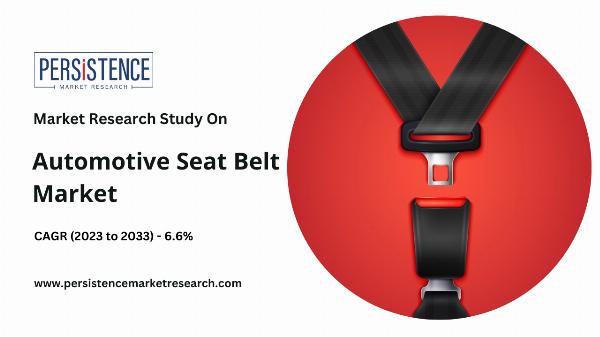Specifications for Safety Belt Anchorages in Automotive Vehicles

Strong 8k brings an ultra-HD IPTV experience to your living room and your pocket.
The Global Automotive Seat Belt Market is projected to grow at a CAGR of 6.6%, reaching a valuation of approximately US$ 15.8 billion by 2033, up from US$ 8.3 billion by the end of 2023. This growth is closely tied to trends in automotive manufacturing, as seat belts play a crucial role in enhancing passenger safety during crashes by distributing impact forces and preventing injuries. Government mandates for seat belt usage have further solidified their importance in vehicle design. Although the market faced challenges during the COVID-19 pandemic, economic recovery is driving a resurgence in automotive production and sales, thereby boosting demand for seat belts, which currently represent 25% to 30% of the automotive passive safety systems market.
Safety belt anchorages are a crucial component in the overall seat belt system, ensuring that seat belts remain securely fastened during a crash and offer maximum protection to the occupants. Proper design, placement, and testing of these anchorages are regulated by stringent safety standards globally to guarantee that they meet performance criteria during accidents. Below, we explore the specifications for safety belt anchorages, their importance, and the regulations that govern their performance in automotive vehicles.
Importance of Safety Belt Anchorages
The performance of seat belts in protecting vehicle occupants depends heavily on how the anchorages hold up during an accident. A faulty or improperly positioned anchorage can result in excessive movement of the occupant, reducing the effectiveness of the seat belt and increasing the risk of injury. Safety belt anchorages ensure the proper restraint of passengers by securely attaching seat belts to the vehicle's structure. They must withstand immense forces during a collision, thereby ensuring that the seat belt stays intact.
Types of Safety Belt Anchorages
There are typically two types of seat belt anchorages used in vehicles:
Fixed Anchorages: These are non-adjustable mounting points where seat belts are attached permanently. Fixed anchorages are commonly used in lap belts and provide a secure point of attachment to the vehicle’s frame.
Adjustable Anchorages: These anchor points allow for the adjustment of the seat belt to accommodate different body sizes and shapes. They are primarily found in three-point seat belts, where shoulder belts can be adjusted to ensure the correct fit for the occupant. This adjustment is vital for maximizing safety and comfort.
Key Specifications for Seat Belt Anchorages
The design and performance requirements for seat belt anchorages are defined by international safety standards such as the Federal Motor Vehicle Safety Standards (FMVSS) in the United States, the European Union's ECE Regulation 14, and ISO standards. Here are some key specifications:
1. Anchor Point Locations
Front Seat Anchorages: Anchor points for front seats should be positioned so that the seat belt can be comfortably worn across the occupant's shoulder and lap. For three-point seat belts, the upper anchorage should be located to the rear and above the shoulder to ensure proper restraint during a collision.
Rear Seat Anchorages: For rear-seat passengers, anchorages should provide sufficient tension to restrain the occupant while allowing enough slack for comfort. Anchorages in rear seats must be positioned in such a way that they prevent the lap belt from riding up onto the abdomen, which could cause injuries.
2. Strength and Durability
Anchorages must be designed to withstand forces far greater than those experienced during typical vehicle operation. Regulations require anchorages to endure substantial loads without deformation or failure. Specifically:
Load Requirements: Anchorages must be able to withstand a minimum force of 13.5 kN (3,034 pounds) for lap belt anchorages and 22.2 kN (5,000 pounds) for combined lap and shoulder belt anchorages. These forces simulate the loads experienced during severe frontal crashes.
Corrosion Resistance: Anchorages should be constructed from materials that are resistant to corrosion, ensuring long-term durability. This is particularly important for vehicles operated in regions where salt, moisture, or other corrosive elements are common.
3. Seat Belt Webbing Geometry
The geometry of the seat belt webbing, which runs through the anchorages, must be designed to minimize slack and maximize comfort. A seat belt with too much slack can reduce effectiveness, while too little slack can cause discomfort. Anchorages must ensure that the webbing is correctly routed and tensioned, maintaining a balance between safety and comfort.
- Webbing Routing: The routing of the seat belt webbing through anchor points must prevent twisting or tangling. A twisted seat belt can significantly reduce its strength during a crash and lead to injuries.
4. Testing Procedures for Anchorages
To ensure the reliability of seat belt anchorages, vehicles undergo rigorous testing before they are deemed compliant with safety standards. The key tests include:
Static Load Test: This test applies a static force to the seat belt anchorage to simulate the loads that would occur in a crash. The anchorage must not break or deform under the applied forces, which range from 9,000 N for lap belts to 22,000 N for three-point systems.
Dynamic Test: In a dynamic test, a crash simulation is performed to evaluate the real-world performance of the anchorage. During this test, seat belts are subject to forces that represent those experienced in a high-speed impact, and the anchorages must hold the belts securely in place throughout the event.
Corrosion Testing: To ensure long-term reliability, anchorages are subjected to conditions that mimic extended exposure to harsh environments (moisture, salt, etc.). This ensures that the materials used in the anchorage will remain intact throughout the vehicle’s life.
International Regulations Governing Safety Belt Anchorages
Several international regulatory bodies and organizations specify the requirements for seat belt anchorages. These regulations ensure uniform safety standards across different regions and vehicle manufacturers:
1. Federal Motor Vehicle Safety Standard (FMVSS) No. 210 (USA)
FMVSS No. 210 governs the performance and location of seat belt anchorages in the United States. It outlines the necessary static and dynamic strength tests, location guidelines, and the load-bearing capacity required for both front and rear seat belts. The FMVSS also mandates that the seat belt must fit occupants of different sizes comfortably and that the anchorages must not deform under high loads.
2. ECE Regulation 14 (Europe)
ECE Regulation 14 is the European standard for seat belt anchorages and covers all passenger vehicles. It specifies the minimum strength, location, and testing requirements for seat belt anchorages, ensuring that they provide optimal protection for both front and rear seat passengers. The regulation also includes requirements for child restraint anchorages.
3. ISO 13216
ISO 13216 sets international guidelines for the installation and testing of child restraint anchorages, also known as ISOFIX. The standard ensures that child safety seats can be securely attached to the vehicle using dedicated anchorage points. These regulations are critical for ensuring the safety of young passengers and work in conjunction with seat belt anchorages.
Future Trends in Seat Belt Anchorage Design
With the automotive industry rapidly advancing, seat belt anchorage design is also evolving. Manufacturers are exploring new materials, such as lightweight composites and high-strength steel, to improve both the durability and performance of anchorages. Innovations such as smart seat belts, which automatically adjust based on passenger weight and position, may also become standard in the future, improving the adaptability and comfort of seat belts.
Another area of development is pre-tensioners, which are being integrated into anchorage systems to tighten seat belts milliseconds before a crash, reducing slack and improving restraint during collisions.
Conclusion
The design and performance of seat belt anchorages are critical to the overall safety of automotive passengers. These anchorages must be able to endure immense forces during collisions and ensure that seat belts perform their life-saving function. As automotive safety standards evolve, so too will the specifications and technology behind seat belt anchorages, continuing to enhance protection for vehicle occupants.
Understanding the specifications and requirements for seat belt anchorages emphasizes their vital role in protecting passengers. As regulations become more stringent and technology advances, the future of seat belt anchorages will undoubtedly contribute to even safer roadways worldwide.
Note: IndiBlogHub features both user-submitted and editorial content. We do not verify third-party contributions. Read our Disclaimer and Privacy Policyfor details.







